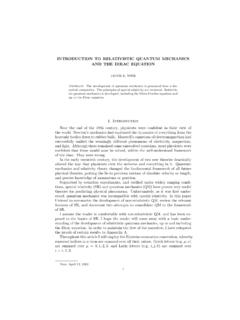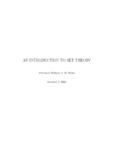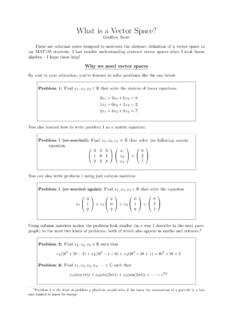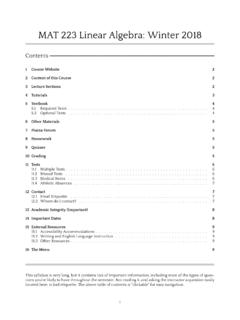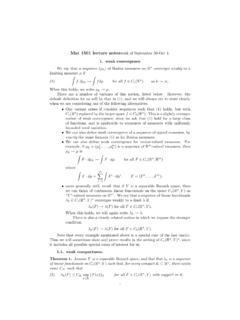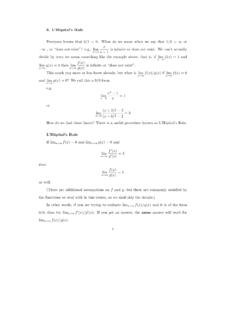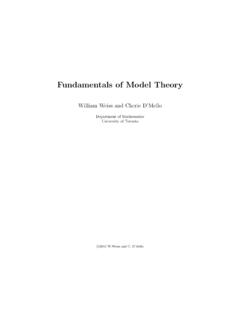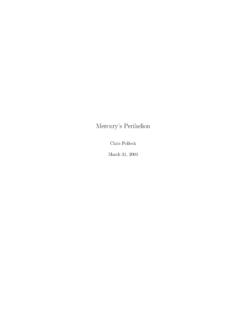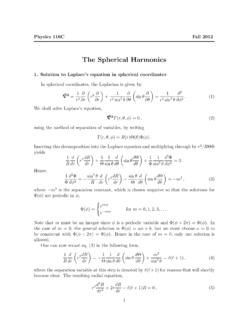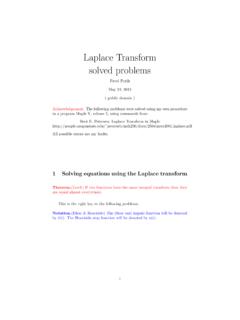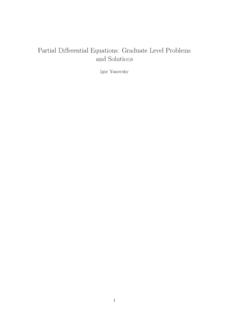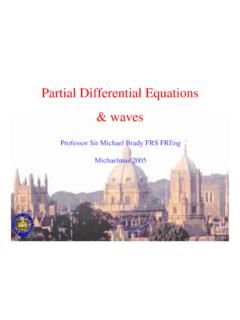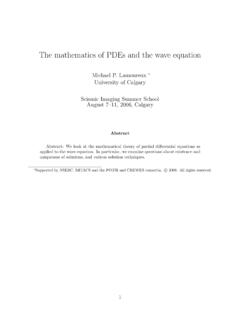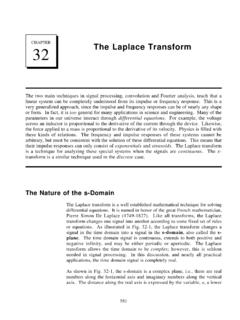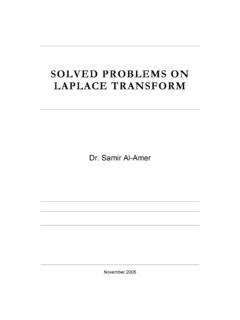Transcription of Partial Differential Equations - » Department of Mathematics
1 Partial Differential Equations Victor Ivrii Department of Mathematics , University of Toronto c by Victor Ivrii, 2017, Toronto, Ontario, Canada Contents Contents i Preface .. iv 1 Introduction 1. PDE Motivations and Context .. 1. Initial and Boundary Value Problems .. 4. Classification of Equations .. 6. Origin of some Equations .. 10. Problems to Chapter 1 .. 14. 2 1-dimensional waves 16. First order PDEs .. 16. Appendix .. 20. First order PDEs (continued) .. 25. Homogeneous 1D Wave equation .. 29. 1D Wave equation reloaded: characteristic coordinates .. 35. Wave equation reloaded (continued) .. 39. 1D Wave equation: IBVP .. 45.
2 Energy integral .. 57. Hyperbolic first order systems with one spatial variable .. 61. 3 Heat equation in 1D 68. 1D Heat equation .. 68. Heat equation (Miscellaneous) .. 73. Project: Walk Problem .. 85. 4 Separation of variables and Fourier Series 88. Separation of variables (the first blood) .. 88. i Contents ii Eigenvalue problem .. 92. Orthogonal systems .. 98. Ortogonal systems and Fourier series .. 103. Other Fourier series .. 108. Calculation of negative eigenvalues in Robin problem .. 116. Multidimensional Fourier series .. 118. Harmonic Oscillator .. 121. 5 Fourier transform 125. Fourier transform, Fourier integral.
3 125. Appendices .. 129. Properties of Fourier transform .. 132. Appendix .. 136. Applications of Fourier transform to PDEs .. 139. 6 Separation of variables 148. Separation of variables for heat equation .. 148. Separation of variables: Misc Equations .. 152. Laplace operator in different coordinates .. 157. Laplace operator in the disk: separation of variables .. 164. Laplace operator in the disk. II .. 167. Linear second order ODEs .. 170. Problems to Chapter 6 .. 174. 7 Laplace equation 177. General properties of Laplace equation .. 177. Potential theory and around .. 178. Green function .. 185. 8 Separation of variables 193.
4 Separation of variable in spherical coordinates .. 193. Separation of variable in polar and cylindrical coordinates . 197. Separation of variable in elliptic and parabolic coordinates . 199. 9 Wave equation 203. Wave equation in dimensions 3 and 2 .. 203. Wave equation: energy method .. 209. 10 Variational methods 215. Contents iii Functionals, extremums and variations .. 215. Functionals, extremums and variations .. 219. Variational methods in physics .. 225. 11 Distributions and weak solutions 232. Distributions .. 232. Distributions: more .. 237. Applications of distributions .. 241. Weak solutions .. 246. 12 Nonlinear Equations 249.
5 Burgers equation .. 249. 13 Eigenvalues and eigenfunctions 256. Variational theory .. 256. Asymptotic distribution of eigenvalues .. 260. Properties of eigenfunctions .. 268. About spectrum .. 278. Continuous spectrum and scattering .. 285. 14 Miscellaneous 290. Conservation laws .. 290. Maxwell Equations .. 294. Some quantum mechanical operators .. 295. A Appendices 298. Field theory .. 298. Some notations .. 301. Contents iv Preface The current version is in the online form This online Textbook based on half-year course APM346 at Department of Mathematics , University of Toronto (for students who are not Mathematics specialists, which is equivalent to Mathematics majors in USA) but contains many additions.
6 This Textbook is free and open (which means that anyone can use it without any permission or fees) and open-source (which means that anyone can easily modify it for his or her own needs) and it will remain this way forever. Source (in the form of Markdown) of each page could be downloaded: this page's URL is and its source's URL is and for all other pages respectively. The Source of the whole book could be downloaded as well. Also could be downloaded Textbook in pdf format and TeX Source (when those are ready). While each page and its source are updated as needed those three are updated only after semester ends. Moreover, it will remain free and freely available.
7 Since it free it does not cost anything adding more material, graphics and so on. This textbook is maintained. It means that it could be modified almost instantly if some of students find some parts either not clear emough or contain misprints or errors. PDF version is not maintained during semester (but after it it will incorporate all changes of the online version). This textbook is truly digital. It contains what a printed textbook cannot contain in principle: clickable hyperlinks (both internal and external) and a bit of animation (external). On the other hand, CouseSmart and its ilk provide only a poor man's digital copy of the printed textbook.
8 One should remember that you need an internet connection. Even if you save web pages to parse mathematical expression you need MathJax which is loaded from the cloud. However you can print every page to pdf to keep on you computer (or download pdf copy of the whole textbook). Due to html format the online version reflows and can accommodate itself to the smaller screens of the tablets without using too small fonts. I. doubt if one can read it comfortably on smart phones (too small screens). Contents v On the other hand, pdf does not reflow but has a fidelity: looks exactly the same on any screen. Each version has its own advantages and disadvantages.
9 True, it is less polished than available printed textbooks but it is main- tained. Victor Ivrii Department of Mathematics University of Toronto This work is licensed under a Creative Commons Attribution-ShareAlike Inter- national License. Contents vi What one needs to know? Subjects Required: 1. Multivariable Calculus 2. Ordinary Differential Equations Assets: (useful but not required). 3. Complex Variables, 4. Elements of (Real) Analysis, 5. Any courses in Physics, Chemistry etc using PDEs (taken previously or now). 1. Multivariable Calculus Differential calculus (a) Partial Derivatives (first, higher order), Differential , gradient, chain rule.
10 (b) Taylor formula;. (c) Extremums, stationary points, classification of stationart points using second derivatives; Asset: Extremums with constrains. Integral calculus (d) Multidimensional integral, calculations in Cartesian coordinates;. (e) Change of variables, Jacobian, calculation in polar, cylindrical, spheri- cal coordinates;. (f) Path, Line, Surface integrals, calculations;. (g) Green, Gauss, Stokes formulae;. (h) u, A, A, u where u is a scalar field and A is a vector field. Contents vii 2. Ordinary Differential Equations First order Equations (a) Definition, Cauchy problem, existence and uniqueness;. (b) Equations with separating variables, integrable, linear.

